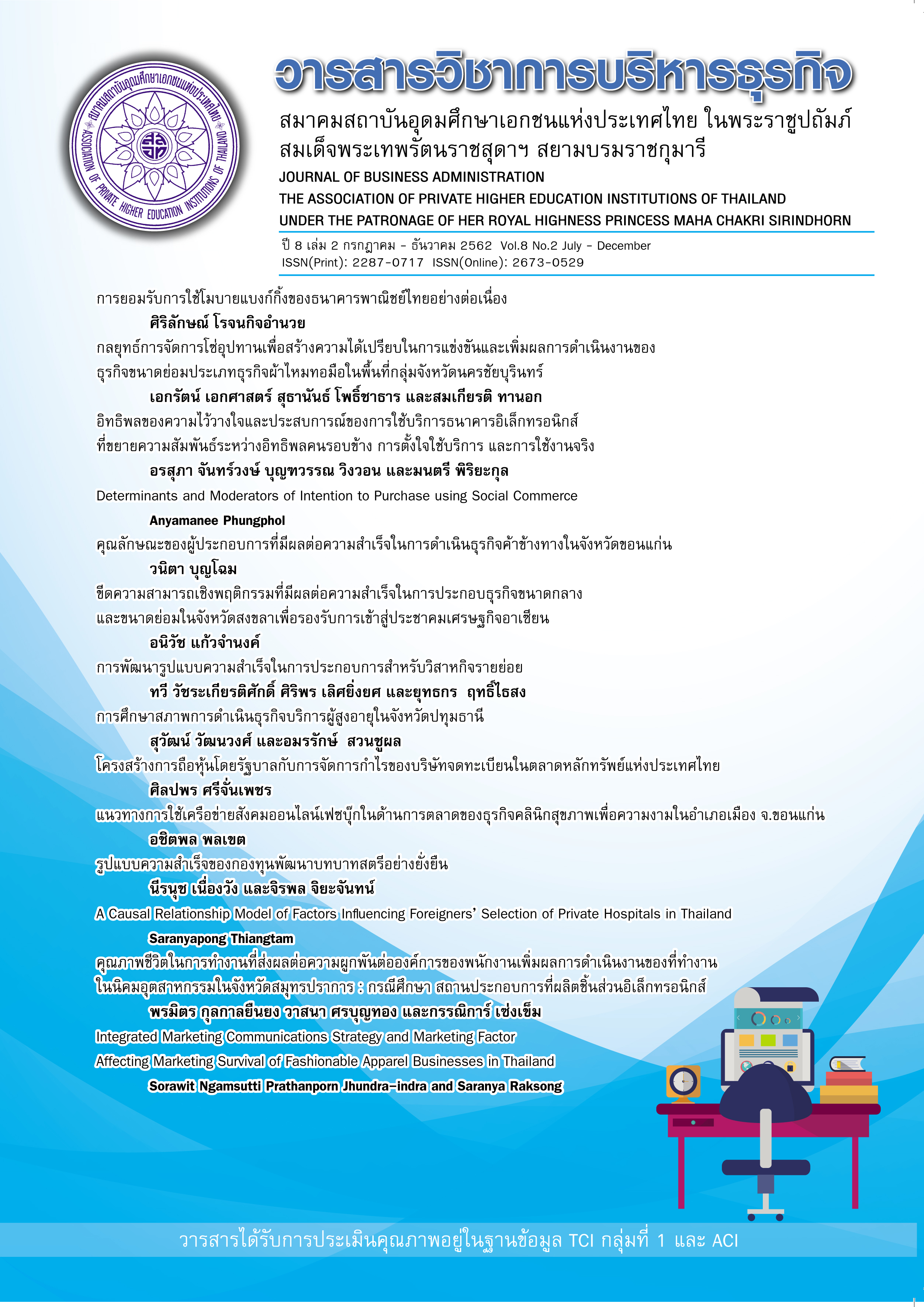The Effects of Quality of Work life toward Organizational Commitment of the Employees Working in the Industrial Estate in Samut Prakarn Province: A Case of Electronics Industry
Keywords:
Quality of Work Life, Organizational Commitment, Industrial Estate, Electronics IndustryAbstract
The purposes of this study were to study 1) work life quality of the employees working in
the Electronics Industry in the Industrial Estate in Samut Prakarn Province 2) the commitment to
organization of the employees working in the Electronics Industry in the Industrial Estate in Samut
Prakarn Province, and 3) the factors relating to work life quality that influence the employeesf
organizational commitment of the employees working in the Electronics Industry in the Industrial
Estate in Samut Prakarn Province. Respondents (N = 387) were sampled from twenty electronics
companies located in Samut Prakarnes three industrial estates: Bang Poo, Bang Plee and Asian
(Suvarnabhumi). Findings revealed that the participants rated their work life quality as moderate,
their commitment to organization as high. A regression analysis further indicated that four
dimensions of work life quality namely, the balance of work life with other life aspects, employee
capability development, advancement and security in the career, sufficient and fair pay and
collaborative working environment had a statistically significant influence on organizational
commitment (p . .05), accounting for 58.5 percent of total variance. Particularly relevant to
manufacturers of electronic components in Samut Prakarn industrial estates, this study provides
a basis for designing a program that strengthens organizational commitment through enhancement
of employeesf work life quality. Recommendations discussed by the researcher include setting
up a plan in advance, allowing extra leaves in case of any emergency, providing non-monetary
rewards, developing employee capability, creating learning culture and building a team working
environment.
References
Alattat, A. R., Som, A. P. M., & Halalat, A. S. (2014). Higher dissatisfaction, higher turnover in the hospitality industry. International Journal of Academic Research in Business and Social Science, 4(2), 45-52.
Bank of Thailand. (2018). Total Value and Quantity of Exports Classified by Product Group. Retrieved from http://www2.bot.or.th/statistics/.
Berger, L. A., & Berger, D. R. (2008). The compensation handbook: A state-of-the-art guide to compensation strategy and design. New York: McGrawHill.
Castells, M., & Peter H. (1994). Technopoles of the world: The making of twenty first century Industrial Complexes. New York: Routledge.
Cochran, W. G. (2007). Sampling techniques. New York: John Wiley and Sons.
Cronbach, L. J. (1951). Coefficient alpha and the internal structure of tests. Psychometrika, 16(3),297-334.
Clutterbuck, D., & Megginson, D. (2005). How to create a coaching culture. People Management.11(8), 44-45.
Daniels, K. (2013). Employee relations in an organizational context: A new approach to industrial relations. London: The Chartered Institute of Personnel and Development.
Daud, N. (2010). Investigating the relationship between quality of work life and organizational commitment amongst employees in Malaysian firms. International Journal of Business and Management, 10(10), 75-82.
Department of Labour Protection and Welfare. (2018). National Wage Committee’s Notification on Minimum Wage Rate (No. 9). Retrieved from https://www.labour.go.th.
Dubrin, R., Champoux, J.E., & Porter, L.W. (1981). Central life interests and organizational commitment of bull-collar and clerical workers. Administrative Science Quarterly, 20, 411-421.
Eastern Economic Corridor (EEC) Office. (2018). Eastern Economic Corridor Development Project. Retrieved from www.eeco.or.th.
Eisenberger, R., Fasolo, P., & Mastro, V.D. (1990). Perceived organizational support and employee diligence, commitment, and innovation. Journal of Applied Psychology, 75(1), 51-59.
Hair, J.F., Black, W.C., Babin, B.J., Anderson, R.E., & Tatham, R.L. (2010). Multivariate data analysis. (7thed.). New York: Pearson.
Huang, T.G., Lawler, J., & Lei, C.Y. (2007). The effects of quality of work life on commitment and Turnover Intention. Social Behavior and Personality, 35(6), 735-750.
Huse, E., & Cumming, T. (1985). Organization development and change. Minnesota : St-Paul West.
Huselid, M.A., & Day, N.E. (1991). Organizational commitment, job involvement, and turnover: A substantive and methodological analysis. Journal of Applied Psychology, 76(3), 380-391.
Kasikornbank. (2018). K SME Analysis. Retrieved from https://www.kasikornbank.com/th/.pdf
Kulkalyuenyong, P. (2016). The importance of employee engagement in the hospitality industry. Dusit Thani College Journal, 10(1), 269-282.
Marta, J. K. M., Singhapakdi, A., Lee, D. J., Sirgy, M. J., Koonmee, K.., & Virakul, B. (2013). Perceptions about ethics institutionalization and quality of work life: Thai versus American marketing managers. Journal of Business Research, 66, 381–389.
Meyer, J.P., & Allen, N.J. (1991). A three-component conceptualization of organizational commitment. Human Resource Management Review, 1(1), 61-89.
Owoyemi, O. A., Oyelere, M., & Elegbede, T. (2011). Enhancing employee’s commitment to organization through training. International Journal of Business and Management, 6(7), 280-286.
Rodrigues, M. V. C. (2002). Qualidade de vida no trabalho. Petr.polis: Vozes.
Schneider, B., & Barbera, K.M. (2014). The oxford handbook of organizational climate and culture. New York: Oxford University Press.
Sirgy, M.J., Efraty, D., Siegel, P., & Dong-Jin, L. (2001). A new measure of quality of work life (QWL) based on need satisfaction and spillover theories. Social Indicators Research, 55(3), 241-302.
Srisa-art B. (2011). Basic Research. Bangkok: Srisuriyasarn.
Steers, R.M. (1997). Introduction to Organization Behavior. New York : Harper Collin.
Tarigan, V., & Ariani, D. W. (2015). Empirical study of the relations between job satisfaction, organisational commitment and turnover intention. Journal of Advances in Management and Applied Economics, 5(2), 21-42.
Truss, C., Delbridge, R., Alfes, K., Shanntz, A., & Soane, E. (2014). Employee engagement in theory and practice. New York: Routledge.
Tulasi, D.V., & Vijayalakshmi, C. (2013). Quality of work life: a strategy for good industrial relations. Advances in Management, 6(11), 8-15.
Walton. R.E. (1974). Improving the quality of work Life. Harvard Business Review, 52(3), 12-16.
Welch, M., & Jackson, P.R. (2007). Rethinking internal communication: A stakeholder approach. Corporate Communications: An Internal Journal, 12(2), 177-198.

Downloads
Published
How to Cite
Issue
Section
License
บทความที่ลงตีพิมพ์ในวารสารวิชาการบริหารธุรกิจ สมาคมสถาบันอุดมศึกษาเอกชนแห่งประเทศไทยต้องเป็นบทความที่ไม่เคยได้รับการตีพิมพ์เผยแพร่ หรืออยู่ระหว่างการพิจารณาตีพิมพ์ในวารสารอื่นๆ การละเมิดลิขสิทธิ์เป็นความรับผิดชอบของผู้ส่งบทความโดยตรง

